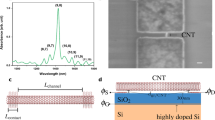Abstract
Carbon nanomaterials, including the one-dimensional (1-D) carbon nanotube (CNT) and two-dimensional (2-D) graphene, are heralded as ideal candidates for next generation nanoelectronics. An essential component for the development of advanced nanoelectronics devices is processing-compatible oxide. Here, in analogy to the widespread use of silicon dioxide (SiO2) in silicon microelectronic industry, we report the proof-of-principle use of graphite oxide (GO) as a gate dielectrics for CNT field-effect transistor (FET) via a fast and simple solution-based processing in the ambient condition. The exceptional transistor characteristics, including low operation voltage (2 V), high carrier mobility (950 cm2/V−1 s−1), and the negligible gate hysteresis, suggest a potential route to the future all-carbon nanoelectronics.
Similar content being viewed by others
References
Avouris P. Molecular electronics with carbon nanotubes. Acc Chem Res, 2002, 35: 1026–1034
Iijima S. Helical microtubules of graphitic carbon. Nature, 1991, 354: 56–57
Trans S J, Verschueren A, Dekker C. Room-temperature transistor based on a single carbon nanotube. Nature, 1998, 393: 49–52
Rueckes T, Kim K, Joselevich E, et al. Carbon nanotube-based nonvolatile random access memory for molecular computing. Science, 2000, 289: 94–97
Appenzeller J, Knoch J, Derycke V, et al. Field-modulated carrier transport in carbon nanotube transistors. Phys Rev Lett, 2002, 89: 126801–126804
Javery A, Guo J, Wang Q, et al. Ballistic carbon nanotube field-effect transistors. Nature, 2003, 424: 654–657
Fuhrer M S, Kmin B M, Durkop T, et al. High-mobility nanotube transistor memory. Nano Lett, 2002, 2: 755–759
Radosavljevic M, Freitag M, Thadani K V, et al. Nonvolatile molecular memory elements based on ambipolar nanotube field effect transistors. Nano Lett, 2002, 2: 761–764
Bachtold A, Hadley P, Nakanishi T, et al. Logic circuits with carbon nanotube transistors. Science, 2001, 294: 1317–1320
Derycke V, Martel R, Appenzeller J, et al. Carbon nanotube inter- and intramolecular logic gates. Nano Lett, 2001, 1: 453–456
Weitz R T, Zschieschang U, Effenberger F, et al. High-performance carbon nanotube field effect transistors with a thin gate dielectric based on a self-assembled monolayer. Nano Lett, 2007, 7: 22–27
Fu L, Liu Y Q, Liu Z M, et al. Carbon nanotubes coated with alumina as gate dielectrics of field-effect transistors. Adv Mater, 2006, 18: 181–185
Javey A, Kim H, Brink M, et al. High-κ dielectrics for advanced carbon-nanotube transistors and logic gates. Nat Mater, 2002, 1: 241–246
Chen Z H, Appenzeller J, Lin Y M, et al. An integrated logic circuit assembled on a single carbon nanotube. Science, 2006, 311: 1735
Du X, Skachko I, Barker A, et al. Approaching ballistic transport in suspended grapheme. Nat Nanotech, 2008, 3: 491–495
Kim K S, Zhao Y, Jang H, et al. Large-scale pattern growth of graphene films for stretchable transparent electrodes. Nature, 2009, 457: 706–710
Westervelt R M. Applied physics: graphene nanoelectronics. Science, 2008, 320: 324–325
Wang X R, Ouyang Y J, Li X L, et al. Room-temperature all-semi-conducting sub-10-nm graphene nanoribbon field-effect transistors. Phys Rev Lett, 2008, 100: 206803
Stankovich S, Dikin D A, Dommett G H B, et al. Graphene-based composite materials. Nature, 2006, 442: 282–286
Cai W W, Piner R D, Stadermann F J, et al. Synthesis and solid-state NMR structural characterization of C-13-labeled graphite oxide. Science, 2008, 321: 1815–1817
Mkhoyan K A, Contryman A W, Silcox J, et al. Atomic and electronic structure of graphene-oxide. Nano Lett, 2009, 9: 1058–1063
Dikin D A, Stankovich S, Zimney E J, et al. Preparation and characterization of graphene oxide paper. Nature, 2007, 448: 457–460
Eda G, Fanchini G, Chhowalla M. Large-area ultrathin films of reduced graphene oxide as a transparent and flexible electronic material. Nat Nanotech, 2008, 3: 270–274
Robinson J T, Perkins F K, Snow E S, et al. Reduced graphene oxide molecular sensors. Nano Lett, 2008, 8: 3137–3140
Gomez-Navarro C, Weitz R T, Bittner A M, et al. Electronic transport properties of individual chemically reduced graphene oxide sheets. Nano Lett, 2007, 7: 3499–3503
Cote L J, Kim F, Huang J X. Langmuir-Blodgett assembly of graphite oxide single layers. J Am Chem Soc, 2009, 131: 1043–1049
Weiss P. Looking for Mr. Goodoxide. Sci News, 2000, 157: 204
Hummers W S, Offeman R E. Preparation of graphitic oxide. J Am Chem Soc, 1958, 80: 1339
Kovtyukhova N I, Ollivier P J, Martin B R, et al. Layer-by-layer assembly of ultrathin composite films from micron-sized graphite oxide sheets and polycations. Chem Mater, 1999, 11: 771–778
Robinson J T, Zalalutdinov M, Baldwin J W, et al. Wafer-scale reduced graphene oxide films for nanomechanical devices. Nano Lett, 2008, 8: 3441–3445
Fu W Y, Xu Z, Bai X D, et al. Intrinsic memory function of carbon nanotube-based ferroelectric field-effect transistor. Nano Lett, 2009, 9: 921–925
Author information
Authors and Affiliations
Corresponding authors
Additional information
Recommended by NIE YuXin
Rights and permissions
About this article
Cite this article
Fu, W., Liu, L., Wang, W. et al. Carbon nanotube transistors with graphene oxide films as gate dielectrics. Sci. China Phys. Mech. Astron. 53, 828–833 (2010). https://doi.org/10.1007/s11433-010-0179-x
Received:
Accepted:
Published:
Issue Date:
DOI: https://doi.org/10.1007/s11433-010-0179-x




